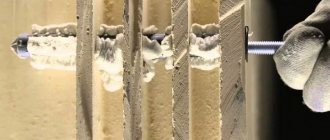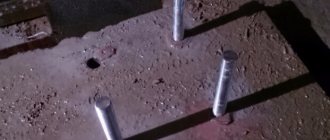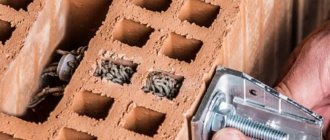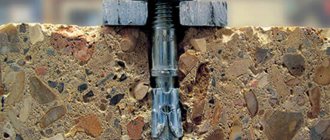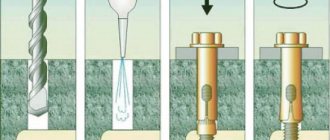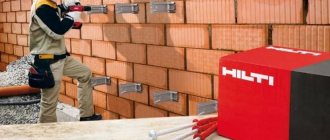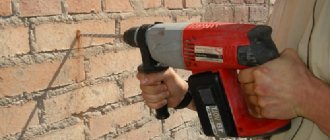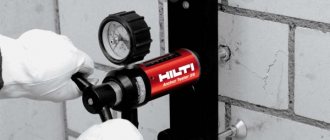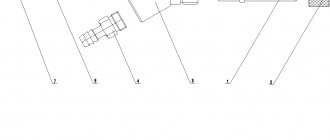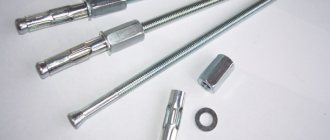The rapid development of construction technologies contributes to the emergence of new building materials and fasteners on the market. One such innovation is the chemical anchor. Although this fastener is not currently widely used, its popularity is steadily increasing.
This type of fastening was originally developed for use in the mining industry. Using chemical anchors, structural elements were fastened to porous and loose rocks that did not have sufficient strength for fastening with metal anchors. The new fastening method turned out to be so effective that it gradually became widespread throughout the construction industry.
This article discusses the principle of operation, main types, advantages, disadvantages and scope of use of chemical anchors. In addition, a list of leading manufacturers and recommendations for independent production of this type of fasteners are provided.
What is a chemical anchor?
A chemical anchor is an innovative fastening system that provides reliable fixation of various elements of building structures in loose, hollow and porous materials. Such materials include:
- shell rock;
- limestone;
- various types of cellular concrete;
- hollow brick.
By themselves, the materials listed above do not have sufficient strength to fasten loaded structural elements, but the use of chemical anchors can solve this problem.
Depending on the material in which one or another structural element needs to be fixed, the chemical composition of the mixture can vary significantly. The exact proportions of the composition, as a rule, are not disclosed by manufacturers, but with a high degree of probability it can be said that the composition of most chemical anchors includes:
- polyurethane, acrylic or polyester resins;
- fine quartz sand;
- cement;
- hardener.
The standard packaging of a chemical anchor resembles a syringe of liquid nails or silicone sealant, but the contents of the container are an effective fastening system that ensures reliable fixation of metal rods in any building material.
Scope of use
The chemical anchor provides increased load-bearing capacity of the connection and is relevant for the following cellular materials characterized by reduced density:
- Foam concrete blocks.
- Shell rock.
- Aerated concrete products.
- Bricks on clinker base.
- Hollow concrete blocks.
Also, high strength of connection is ensured with:
- reinforced concrete;
- brick;
- stone;
- concrete structures.
It is often called liquid or adhesive dowel
The chemical anchor is indispensable to ensure reliable fixation. It applies:
- In dilapidated walls.
- In a humid environment.
- In porous masses.
The hardened composition with metal reinforcement can be installed close to the edge of the structure. It allows you to secure:
- suspended ceilings;
- lighting structures;
- advertising banners located on the facades of buildings;
- structural elements of swimming pools.
An anchor for foam blocks, as well as other types of cellular concrete, provides waterproofing and reliably retains heat.
Operating principle of a chemical anchor
The principle of operation of the fastening system under consideration is that the working mixture, penetrating deeply into the pores and cavities of the material, hardens and ensures the fixation of metal rods even in cellular concrete and hollow brickwork.
Installing chemical anchors is not particularly difficult. The adhesive mixture is introduced into a pre-prepared hole, after which a threaded rod or conventional corrugated fittings are installed there. The filler tightly envelops the rod and hardens, thereby ensuring its reliable fixation. Depending on the type of chemical anchor, a special dispenser gun or a special capsule may be used to fill the hole with adhesive.
Chemical anchors are significantly superior to conventional anchor systems and dowels in their ability to withstand pull-out loads. The load-bearing capacity of chemical compounds allows the use of this method of fastening when installing balconies, canopies and even bridges, both above and below water.
It is especially advisable to use chemical anchors in cases where neither dowels nor conventional metal anchors are able to guarantee reliable fastening of structural elements to the base. Typically, this situation occurs if the base is a porous or hollow material, for example, shell rock, limestone, gas or foam concrete, cinder block, etc.
When using a fastener element, it must be remembered that the setting and complete hardening of the filler depends on its composition and can range from 5 to 24 hours.
Price
Of course, the price of a product depends on a lot of factors. But, in general, the product in ampoules can be purchased for 200 - 600 rubles. Fasteners in capsules or tubes can be purchased by paying 1800 - 2400 rubles. Agree, the price is steep, but...
A chemical anchor is a guarantor of reliable connection of all kinds of elements on surfaces made from a variety of raw materials! Solid, safe and durable fastening to you, friends! Bye!
Wisdom Quote: Strong people are always simple (Leo Tolstoy).
Application area
Let us consider in more detail in which cases it is advisable to use chemical anchors. According to reviews from builders and recommendations from manufacturers, chemical anchors are most often used for:
- arrangement of highways and other road works related to the installation of signs, signs, advertising brochures, etc.;
- installation of ventilation systems on loose, porous and hollow foundations;
- reliable fixation of large metal structures;
- installation of massive advertising structures characterized by increased windage;
- restoration of various types of lifts;
- erection of scaffolding and sheathing;
- restoration of monuments;
- carrying out installation work in port areas and construction of various water bodies;
- installation of funiculars used at ski resorts;
- arrangement of electrical facilities.
In domestic conditions, chemical anchors may be required to attach heavy hanging furniture and interior items to an insufficiently strong base.
Types of hardware for foam blocks
In addition to sand, cement and water, foam concrete also contains a foaming agent. Giving the blocks lightness, good thermal insulation and a porous structure, it simultaneously makes the material fragile. Fixing interior items or furniture into such products is a rather difficult task.
There are also certain difficulties when connecting foam blocks to each other in a corner bandage, attaching them to the foundation or facing layer. To solve these problems, special types of hardware products are being developed that are intended specifically for cellular concrete.
Fasteners of this type must solve several main problems:
- Increasing the support area;
- Increased friction force inside the foam block;
- Ensuring reliable fastening inside the porous base without crushing it.
The main task of any hardware is fastening strength
Most often, the following types of fasteners are used for working with lightweight concrete:
- Bimetallic screws with galvanized or plastic dowels are the simplest and cheapest type of hardware. It is well suited for fastening light objects, as it is not very reliable. Such fastenings operate using the dowel expansion method, or, due to the spiral threaded part, they are screwed into foam blocks without additional spacers. They can be made in different sections, lengths, to work with different tools.
- Metal anchors operate by wedging at the base of the block. These may be end petals that open inside after the end nut is tightened. Another option is to bend the side segments to the sides when screwing in a bolt or stud. This type has a more reliable fastening.
- Chemical anchors are most often used in cases where the object being secured has a significant weight. They work similarly to mechanical anchors, but they are installed with an adhesive compound.
Metal anchor with spacer
Mechanical fasteners
Dowel with expansion
Comparison of mechanical and chemical fasteners
Their operating principle is somewhat different, but they distribute the entire load not pointwise, but over the entire length and diameter of the fastening element. Let's take a closer look at the last type of fastener.
Types of liquid anchor
As mentioned in previous sections, chemical anchors are typically two-part formulations consisting of synthetic resins and a hardener. The ingredients are mixed immediately before using the anchor. There are three types of packaging for chemical anchors:
- ampoule.
They are a capsule with two compartments, one of which contains the adhesive mixture, the other contains the hardener; - single cartridge.
Inside the cartridge there is a special partition separating the adhesive and hardener; - two-cartridge.
The kit includes two cartridges, one of which contains an adhesive, the other a hardener.
The compositions produced in cartridges work on the same principle, however, to use them you will need various dispensing guns designed to dose the mixture into a pre-prepared hole (hole).
Ampoule anchors
The main feature of such fasteners is that the diameter of the ampoule strictly corresponds to the specific diameter of the prepared hole (borehole). One ampoule is intended to fix one rod (stud, screw, etc.). It is advisable to use ampoule anchors in cases where high accuracy and cleanliness of the hole can be guaranteed.
Capsule anchors are convenient to use because there is no need to control the degree of filling of the hole. Minor differences in the diameters of the hole and capsule are fully compensated by the expansion of the adhesive composition as it hardens.
As mentioned above, the ampoule has two capsules: with an adhesive mixture and with a hardener. The connection of these components occurs by screwing in a threaded metal rod, such as a stud or screw. It should be noted that mixing of the hardener and filler occurs more evenly than when using compounds packaged in one or two cartridges.
The disadvantages of capsule chemical anchors include the inability to use them in a vertical position. This is due to the fact that the filler will flow out of the hole much faster than setting occurs.
Cartridge anchors
As mentioned above, this type of anchor can be placed in one tube, separated by a partition, and in two separate cartridges.
When using one cartridge, the filler and hardener simultaneously enter the cavity of the mixing spout, where they are mixed using a special spiral insert. To work with such anchors, you can use a regular construction dispenser gun.
The two-cartridge system works a little differently. Mixing of components also occurs in a common spout, but they go there separately. To work with such packaging, you will need a special dispenser gun that ensures simultaneous supply of filler and hardener into the mixing spout.
Types of cartridge anchors
All cartridge anchors can be divided into two types:
- universal;
- for fastening metal rods in concrete foundations.
Universal chemical anchors
The popularity of this type of anchor fastening is due, first of all, to its ease of use. During installation work, there is no need to accurately calculate the volume of material required for one fastening.
Anchors designed for attaching metal rods to concrete foundations
Chemical anchors, the main purpose of which is gluing threaded or reinforcing bars into a concrete base, most often have a thick consistency. In addition to the main components, their composition includes corrosion inhibitors and deoxidizers, which significantly increases the reliability and service life of the fastener.
Some types of chemical anchors intended for concrete are used only in combination with special chemicals designed to treat the rods and drilled holes. In addition, special devices may be required to press the rods into the holes.
A significant disadvantage of cartridge anchors is the difficulty of controlling the filling of holes with adhesive. If the amount of working mixture is insufficient, it begins to flow out of the hole if the base is porous or hollow type without waiting for setting.
You can significantly reduce the consumption of filler and achieve its uniform distribution on all sides of the hole by using special mesh bushings. These elements can have different sizes and are selected specifically for a specific mount.
Anchoring technology
Fastening is based on the occurrence of a reaction between materials. Chemical solutions for work, polyester resin and hardener are supplied in two types of packaging (containers) - glass ampoules and tubes (cartridges). Their mixing causes chemical and physical fixation processes. The speed of fixation of the structure depends on the type of chemical composition of the mixture and the physical state (humidity, temperature) of the environment.
Ampoules .
The size of the ampoule is designed to achieve maximum loads on the fastener and corresponds to the size of the anchor. A hole of a given size is drilled, an ampoule is inserted into it, and then a pin is hammered or screwed in. The fasteners can be made locally or purchased from the company along with the ampoules. Ampoules are divided by diameter and used for fastening in holes of a certain size. Cartridges . In cartridges, the compositions are separated and, during extrusion, mixed inside a nozzle-nozzle, which has a special spiral design. They differ in size and layout of departments for trains. The composition is poured from the cartridge into the drilled hole using a special dispenser pistol. Advantage - they are used for fixing anchors in holes of any size, even those significantly exceeding its diameter.
Before installing the fasteners, the holes should be cleared of dust and dirt. When using a cartridge for hollow structures, a perforated polyester cartridge is first inserted into the hole. Due to the expansion of the solution flowing through the holes, additional fixation of the chemical anchor into the concrete is created in the wall of the cartridge.
It is possible to use cartridges as glue for fixing products made of different materials to each other. They are also used for repair work when filling cracks and holes.
Chemical stud anchor . Holes are formed symmetrically in the fixed working surfaces, which are filled with a chemical solution from the cartridge; ampoules are used less often. The products are connected through an inserted pin.
When working with large volumes and surfaces, components are supplied in cans. To apply them, special pumps and mixer attachments are used, and specially trained personnel are required for permission to work.
Chemical anchors are used as reliable fastenings in many areas of modern construction:
- road construction (installation of noise barriers, barriers, information boards, lighting masts);
- ventilated facades (used for fastening structures to hollow bricks and cellular concrete);
- installation of complex structures (balconies, consoles, columns, creation of reinforcement outlets);
- installation of more decorative structures (railings, canopies, lighting, stucco);
- advertising (used for installing signs, banners, banners, information structures);
- elevator service (repair and installation of shafts, equipment fastening, escalators);
- installation of auxiliary construction equipment (scaffolding, cranes);
- installation of industrial equipment (oil refining equipment, conveyors, machine tools);
- warehouses (racks, lifts, conveyors);
- assembly of buildings from blocks (attaching frames to foundations and blocks to them);
- strengthening the strength of the structure and foundations (metal structures, impregnation of masonry walls);
- restoration of buildings (used for installing floors, restoring masonry, attaching new structures to existing ones);
- offshore construction (ports, locks, oil terminals);
- water entertainment industry (water parks, swimming pools, etc.);
- airports (runways, mounting of antennas and navigation equipment);
- winter recreation industry (lifts, funiculars);
- energy (nuclear power plants, state district power plants, transformers, power line supports);
When choosing to use this type of fastener, a significant cost reduction is also taken into account. Savings reach up to 50% compared to using traditional types of anchors, especially when using large sizes. There is a reduction in inventories in the warehouse and a reduction in overhead costs due to the possibility of manufacturing anchors of any shape on the construction site, as well as reducing their total quantity in work per unit area of the fixed product. Thanks to its characteristics, any fastening work is easier and faster when using a chemical anchor.
Chemical anchors expand the horizons of construction. An increasing number of them are appearing on the market with new enhanced fixation properties.
On our website FORUMHOUSE you can read about the experience of using this type of fastener. Also read our article about traditional self-tapping screws, screws and anchors.
Editor: Adamov Roman.
This is interesting: How to choose the right drill for a dowel for fastening various objects
Advantages and disadvantages
Like any other elements of building structures, chemical anchors have their advantages and disadvantages. To avoid unpleasant moments during installation and operation, it is necessary to take into account both the positive and negative features of this type of fastening.
The undeniable advantages of chemical anchors include:
- complete sealing of the hole after installing the rod;
- No tensile stresses in the concrete base.
- Versatility and wide scope of application;
- ease of installation. Installing a chemical anchor does not require experience or special skills;
- high strength characteristics of the anchor fastening after its complete polymerization. In this indicator, chemical anchors are significantly superior to metal anchors and dowels with a plastic sleeve;
- ability to withstand significant mechanical loads and tensile forces. In other words, the fastening element has a high load-bearing capacity;
- chemical anchors are not susceptible to external atmospheric influences, corrosion processes, or the effects of aggressive chemical compounds;
- special chemical anchor compounds can be used in conditions of high humidity and on waterlogged surfaces; in addition, installation of underwater structures is quite acceptable;
- the service life of such fastenings is comparable to the durability of the base itself and is usually at least 50 years;
- There are adhesives that do not contain any toxic compounds. It is advisable to use such fastenings for interior work. When purchasing chemical anchors, you need to make sure that the mixture is environmentally safe;
- The thermal expansion coefficients of fasteners and base materials are approximately equal. This eliminates the occurrence of additional internal stresses during sudden temperature changes.
Along with the above advantages, when starting to use, you should keep in mind the following disadvantages:
- Unlike metal anchors and dowels, chemical anchors require quite a long time until the installed anchor is fully ready to bear the load. The time for complete polymerization of the fastener depends on the ambient temperature:
— at a temperature of +200C, the time for complete polymerization will be from 25 to 40 minutes; will be 25÷40 minutes;
— at 50C this period will be 6 to 7 hours;
- with a further decrease in temperature, the polymerization process may stop altogether.
- Limited shelf life of unopened packaging. When packaged, the composition can be stored for no more than 1 year;
- Once the package is opened, its shelf life is significantly reduced. Based on this, it is necessary to plan installation work in such a way that the packaging is completely consumed at one time. In other words, it is not practical to print packaging for one or two mounts. In this case, ampoule anchors can come to the rescue;
- The high price sharply reduces the demand for this type of fastening.
Advantages and disadvantages
Like all fasteners, chemical anchors have pros and cons to their use. The undoubted advantages of this fastener are the tightness of its connection with the material and the ability to withstand significant loads. Also, the composition and structure of the chemical anchor prevent the appearance of cold bridges in the places where they are installed.
The fastener also has significant disadvantages, such as the impossibility of dismantling the chemical anchor after the composition has hardened, and its high cost.
There is also a need to correctly calculate the adhesive composition for installing the anchor. The consumption of the adhesive composition will increase in proportion to the porosity of the material into which the fastener will be installed. So a chemical anchor for concrete will require more adhesive than an anchor for brick.
Types of guns for chemical anchors
The use of a cartridge chemical anchor is impossible without the use of special dispensing guns. If the material is packaged in one tube, there are no problems: you can use a regular mounting gun. If the filler and hardener are in different tubes, you cannot do without a dispenser gun of a special design, which ensures the simultaneous supply of ingredients into the mixer spout.
In order to effectively use the dual cartridge dispenser gun, some practical skills will be required. First of all, it is necessary to be able to determine with a high degree of accuracy the required volume of anchor mixture. It depends on several factors:
- diameter of the fixed rod;
- hole depth;
- the presence of a mesh sleeve;
In addition, it is necessary to take into account possible losses of the adhesive mixture during the installation process.
The cost of a dispenser gun for chemical anchors can range from 1,300 to 7,000 rubles. The most expensive and versatile models from Hilti can be used at any ambient temperature. Models are distinguished by a wide selection of dispensers; in addition, the kit may include mounting rods.
Fisher pistols are a budget modification of the tool, and are usually used when carrying out repair work on a small scale.
Models from BIT United Ltd. have gained wide popularity among ampoule automatic dispensing guns. The main advantage of this tool is its affordable price, which, depending on the configuration, can range from 700 to 1000 rubles.
Installation nuances
Now let's figure out how to install a chemical anchor with your own hands.
There are two methods, not counting the option with a metal sleeve, which is suitable for hollow bricks.
First of all, we drill a strictly perpendicular hole for mounting the anchor.
- Then, using a brush, a small brush or an ordinary medical bulb (enema), we remove all the remaining debris and dust from inside.
- We fill the hole about 3/4 full with the injection solution - no more is needed, since it will be squeezed out when installing the rod.
- Screw the fastener into the glue, making sure it is centered and level. We stop when we reach the mark on the thread. Carefully remove excess mixture.
- The solution is left to dry for the time specified by the manufacturer of the composition.
- Once dry, you can hang weights on the threaded fastener and secure them with a nut.
Reinforced joint
The following method is not technically very different, but creates a stronger joint - it is suitable for more porous materials.
To implement it, you will need a metal stop for the drill so as not to destroy the edge of the block.
- We drill a hole, having previously installed the limiter;
- Once the desired depth is reached, the drill begins to make circular movements to create an expanding cavity inside, as in the picture above.
- The rest of the installation is similar - we clean the hole from dust, fill it with a hardening mixture, insert the fastening rod, and wait for it to dry.
As you can see, anchoring aerated concrete blocks is not such a difficult task, and given the softness of this material and the ease with which it is drilled, the work is often done even easier and faster than with classic dowel screws on concrete. For a more detailed introduction to chemical anchors, we recommend that you watch the video in this article.
How to choose a chemical anchor for aerated concrete, concrete and brick
Depending on the base material, different anchor mixtures are used. It is extremely important to ensure that the chemical composition of the anchor matches its characteristics and operating conditions. In order to accurately select a material, before purchasing it, you should carefully study the instructions included with it or located on the packaging. This document contains all the necessary information.
Most well-known manufacturers indicate in their recommendations the types of structures and materials for their manufacture, the optimal location of mounting holes and their sizes, the method of fastening, the range of humidity and temperature, as well as permissible loads for various bases. In addition, it is necessary to take into account possible limitations on operating conditions and the rate of polymerization of the mixture - this is of particular importance for chemical anchors with atmospheric polymerization.
How to install an anchor bolt in concrete
The whole process is quite simple, the main thing is to take the measurements correctly and implement everything as accurately as possible. But there are several nuances that need to be taken into account.
Practical tips for installing anchors in concrete:
- The strength of the fastener is influenced not only by the anchor, but also by the quality of the base material (concrete in this case), proper preparation for installation, taking into account the material of the attached structure and the design of the bolt itself.
- If a layer of finish is applied to the wall, the hole must be deeper because the finish is usually less durable than concrete.
- It is advisable to take a drill 0.5 millimeters thinner than the diameter of the future hole.
- When working with a hammer drill, it is best to use a tip made of a special carbide material.
- Read the instructions carefully - the packaging with anchors should indicate the permissible force and the maximum number of revolutions.
- When screwing the anchor into, under no circumstances should you twist it all the way, as the material may collapse.
Eternal fastener: concrete dowel
A dowel is a spacer element made of polypropylene or nylon, which is similar in function and performance to an anchor. It cannot be used independently; it is fixed in concrete with special nails or self-tapping screws. To strengthen the fixation, it is often performed with spikes or antennae.
This type of fastening is used where there are not too large loads on the concrete - fastening shelves, TV hooks, lighting fixtures. The dowels are driven into the dowels with a hammer, and the screws are screwed in with a screwdriver or screwdriver. You will also need a regular hammer to drive in nails.
You can also find dowel nails designed for use with a mechanical gun. The fasteners in concrete are made of metal; in appearance, they somewhat resemble a bullet. Relevant where you need to hang a large number of small items.
Concrete dowel: fast but durable
Pins are those that are most often used for arranging fasteners near the edges of a concrete wall. The fastener does not require additional fixation; it is screwed into the hole, where a little epoxy glue is first poured. There is no need to drill holes - the dowel can be screwed directly into the concrete wall. If you still need to make a hole in concrete, then it is better to choose a drill (a hammer drill can damage the wall).
They screw it in with a screwdriver - and after that it is no longer possible to unscrew the dowel back. Therefore, preliminary marking must be done especially carefully.
The best manufacturers
Currently, several well-known companies occupy leading positions in the chemical anchors market. Below is a list of these companies and the technical characteristics of their products.
| (Germany) | ||
| R.M. | “Reaktionsanker” is an ampoule with an adhesive mass, inside of which there is a compartment with a hardener. The manufacturer produces ampoules of different sizes - M8 (10×80), M10 (12×90), M12 (14×110), M16 (18×125), M20 (24×170), M30 (30×280). | |
| FHP | “Hammerpatrone” is an ampoule with glue and hardener for installing metal elements into a concrete base. Produced in the following sizes – 10 (13×90), 12 (15×110), 16 (18×125), 20 (24×180). | |
| FIS V 360S | “Injections-Mortel” Double cartridge, requires a special gun to operate. Main cartridge with a volume of 360 ml and two mixers. | |
| FIS VS 150 | "Injections-Mortel" One standard size cartridge. To work, you will need a regular construction gun for standard cartridges. The kit includes a 150 ml cartridge, two mixers and an adapter. | |
| (Liechtenstein) | ||
| HVU | "Adhisitive Capsule Anchor". Ampoule with methacrylic polyurethane resin, quartz sand and hardener. Capsules have the following volume: M8 (10×80), M10 (12×90), M12 (14×110), M16 (18×125), M20 (24×170), M30 (30×280), M33 (37 ×300), M36 (40×330), M39 (42×360). | |
| HIT-HY150 | "Fast Curinq Injection System". These are two dual cartridges with acrylic resin and hardener. A special gun is required for operation. Cartridge volume 330 ml and two hardeners, HIT-HY20 has one hardener. | |
| HIT-HY20 | ||
| (Switzerland) | ||
| MSP | "Schlagpatrone". Ampoules with resin and hardener. Capsule volume: M8 (10×80), M10 (12×90), M12 (14×110), M16 (18×125), M20 (24×170). | |
| MYA | "Verbunanker". Ampoules with two components. Volume: M8 (10×80), M10 (12×90), M12 (14×110), M16 (18×125), M20 (24×170), M30 (30×280). | |
| MIT-P | One cartridge. A standard construction gun is used for the job. Cartridge volume 150 ml, two mixers. | |
| MIT-P | Double cartridge. Set: 235 ml and two mixers. | |
| MIT-SF | Double cartridge. Volume 380 ml and two mixers. | |
| (Finland) | ||
| KEM | “Kemiallinen ankkuri” – ampoules with polyester resin and hardener, volume M8 (10×80), M10 (12×90), M12 (14×110), M16 (18×125), M20 (24×170), M30 ( 30×280). | |
| KEMLA | “Kemiallinen lyontiampulli” – ampoules with polyester resin and hardener, volume M8 (10×80), M10 (12×90), M12 (14×110), M16 (18×125), M20 (24×170). | |
| ITH | "Injektointitekniika". Cartridge with injection mass based on polyester resin, volume 380 and 150 ml | |
| (Germany) | ||
| TVA | "Verbund-Anker". Ampoules with resin and hardener volume M8 (10×80), M10 (12×90), M12 (14×110), M16 (18×125), M20 (24×170), M30 (30×280). | |
| THP | "Hammerpatrone". Ampoules with resin and hardener, volume M8 (10×80), M10 (12×90), M12 (14×110), M16 (18×125), M20 (24×170). | |
| TVM-K | "Verbundmortel". Cartridge with injection mass, volume 380 and 150 ml. | |
Is it possible to make a chemical anchor yourself?
Factory-made chemical anchors are quite expensive and also have a limited shelf life, especially after unpacking the cartridge. Meanwhile, it is quite possible to make a chemical anchor yourself at home.
The composition is made on the basis of epoxy resin. The physical and technical characteristics of this component fully ensure excellent adhesion to shell rock, limestone, brick, concrete and many other materials. Thanks to these properties, epoxy resin may well become the main component of a homemade chemical anchor.
To make liquid fasteners at home you will need:
- epoxy resin ED-20;
- hardener UP-583;
- Cement or plaster. A small amount of fine quartz sand can be used as a filler;
- Plasticizer DBP or DEG-1.
The preparation of the mixture consists of several stages:
- A plasticizer is added to the epoxy resin in a volume of 5 to 10% of the resin volume, after which the resulting mixture is thoroughly mixed.
- After this, filler (cement or gypsum) is added to the resulting composition. The resulting substance is mixed until a homogeneous mass without lumps is obtained. The amount of filler also ranges from 5 to 10% of the total volume of the mixture.
- The last step is to add hardener in a ratio of 1:10 or 1:8. The rate of polymerization of the composition and its strength will depend on the amount of hardener.
After thorough mixing, a ready-to-use mixture is obtained, which must be processed immediately after preparation. The setting time of the mixture is 1-2 hours, depending on the ambient temperature. Complete polymerization of the composition can last from 12 to 24 hours. The use of a plasticizer allows you to extend the life of the mixture, and the use of gypsum as a filler, on the contrary, speeds up the setting process.
Adviсe
When purchasing a chemical anchor, you need to pay attention to the date of its production - even in unopened packaging, the adhesive composition is stored for no more than a year.
The speed of setting of the adhesive composition and its complete hardening directly depends on the temperature in the room. Therefore, it is worth reading the instructions, which will indicate how long it will take for the resins to harden at a certain temperature.
It is also worth considering that for installing chemical anchors at temperatures below +5 ˚С, a special adhesive composition is used, which differs from the usual one.
How to use a chemical anchor
To use a chemical anchor, no special knowledge or practical skills are required. The procedure is quite simple and straightforward.
If an ampoule anchor is used, the ampoule should be placed in the hole and split with a metal rod. As a result, the components mix and harden.
When using the substance in cartridges, the required amount of adhesive mixture is squeezed into the cleaned hole, after which a metal rod is installed. After the time specified in the technical specifications, the mixture completely hardens, thereby ensuring reliable fixation of the rod.
Dimensions and characteristics of anchor bolts
Initially, before choosing a pin, you need to know the dimensions, since fasteners come in all sizes and calibers.
Groups of anchors by size: small – in section up to 8 ml/length up to 55; middle – up to 12/120 ml; large – with the largest dimensions D=24 and L=220 ml.
Foundation pins with different dimensions, their parameters are determined by 3 characteristics.
Let's decipher the marking M8 10/60-115: D of cutting - M8, outer D = 10 (this D coincides with D of the drill with which the hole will be drilled), length of the pin - 115 ml, thickness of the part - 60 ml.
All operational parameters of the anchors are indicated in the report card, these will be mass, maximum torque and bending period, minimum pulling power, rational overloads. In accordance with the various given characteristics, the necessary models are selected and a good connection is made to the concrete structures of the pin.
How can I replace a chemical anchor?
Considering the high cost of chemical anchors, the question often arises: what can replace them. It is indeed possible to replace the factory chemical version, but it is necessary to take into account the base material.
For heavy concrete, a classic metal anchor is best. To be fair. It should be noted that such bases do not really need liquid fasteners at all.
When it comes to cellular concrete, a homemade epoxy resin-based anchor can be a good alternative to a factory-made chemical anchor. In addition, the use of drywall adhesive and some other gypsum-based mixtures gives good results. To achieve maximum fastening strength, holes should be drilled in the shape of a reverse cone.
Despite their high cost, chemical anchors are increasingly used to fasten building structural elements to loose, porous and hollow substrates. In terms of their strength characteristics, such fastenings are significantly superior to conventional metal anchors and dowels with plastic sleeves, especially when fastening to weak foundations.
Concrete dowel - fast but durable
Dowels, or concrete screws as they are also called, are an indispensable tool for securing everything you need in a rather difficult place - at the edge of a concrete wall. This fastener does not require additional fixation due to direct screwing into the prepared hole, after drilling which you need to remove dust particles. To increase the strength of the fastening, you can pour a small amount of epoxy glue into the hole.
Using a dowel
Most dowel applications require no pre-drilling because the fastener is screwed directly into the concrete. If preparing a hole cannot be avoided, use a drill to create it, but not a hammer drill.
A tool with more power can lead to the destruction of the wall. Screwing is done with a screwdriver, after which it is almost impossible to remove the dowel from the concrete, so you should take measurements with the utmost care. (See also the article Sealant for concrete: features.)
The secret to selecting the necessary drill to create holes for placing any type of fastener is extremely simple: their diameters must match completely. This means that an anchor with a diameter of 8 mm must be installed using an 8 mm drill.
